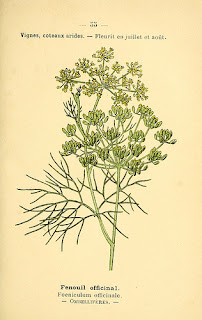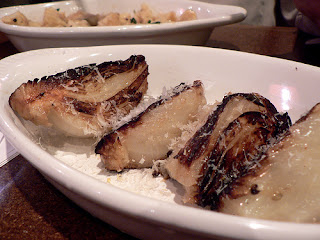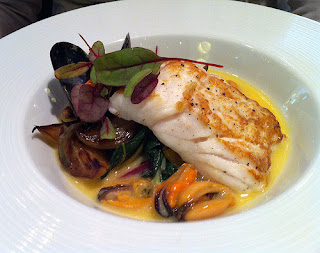from
Behind the French Menu
by
Bryan G. Newman
behindthefrenchmenu@gmail.com
Wild fennel flowers.
Using the fennel leaves and seeds.
The fennel bulb (root) bulb.
The fennel bulb or root is used as a vegetable, it is crisp and often served raw, but it may also be braised, grilled, fried or stewed; the anise flavor of the bulb is much much lighter than that of the leaves. The root or bulb of the fennel plant in French is fenouil racine.
Fennel flowers and leaves.
https://www.flickr.com/photos/biodivlibrary/6022562110/
Wild fennel
The fennel seeds, the graines de fenouil and leaves from wild herbs are preferred by French chefs for fish and shellfish dishes. Gathering wild fennel is somewhat like collecting wild mushrooms with many restaurants employing ramasseurs, gatherers. These professionals as well as bringing wild mushrooms, in season bring herbs and fruits. Fennel seeds and leaves will be in salads, soups, and stews and are often included in the herb group Herbes de Provence.
Fennel on French Menus:
Filet de Bar Grillé, Fondant de Fenouil aux Raisins de Corinthe – A grilled filet of European Sea Bass served with a thick warm sauce of raisins made with black Corinth grapes and fennel.
Grilled fennel bulbs (roots).
https://www.flickr.com/photos/stuart_spivack/2110306208/
Faux-filet de Bœuf Charolais du Bourbonnais AOP-Bœuf du Bourbonnais Caramélisé à la Tomate, Purée Fenouil, Rattes de Pays. A North American rib steak or in the UK a sirloin steak from the Charolais cattle; this is one of Frances most famous breeds. The steak is caramelized with tomatoes and served with pureed fennel root and the favorite local ratte potatoes
Fennel seeds.
https://www.flickr.com/photos/zoyachubby/463983617/
Filets de Rougets Justes Saisis, Pommes De Terre Et Fenouil Fondants, Jus Réduit Comme une Soupe De Poisson – Filets of red mullet served exactly when ready with potatoes and warm fennel. The dish is served with a sauce flavored like a fish soup.
Maigre Poêlé sur la Peau, Fenouil Confit à l'Huile d'Olive de Nyons - Meagre or Croaker, the fish, cooked in its skin, prepared with a fennel jam made with the olive oil of Nyons.
Filet de Bar Sauvage Amandes et Noisettes au Beurre de Fenouil. Filet of wild European Sea bass prepared with almonds, hazelnuts, and fennel butter. The emphasis on wild sea bass is so the customer clearly understands that these are not fish from sea farms, but truly wild.
Fennel bulbs (roots).
https://www.flickr.com/photos/mieruzena/3428441886/
Pavé de Cabillaud sur Fenouil Confit aux Aromes d'Ananas, Beurre Au Citron Vert. A thick slice of cod prepared on a bed of fennel jam scented with pineapple and served with lime butter.
Fennel and tomato soup
https://www.flickr.com/photos/perhapstoopink/332621820/
Médaillon de Sole au Fenouil Racine Crevettes à la Sauce aux Herbes. A filet of sole served with fennel root and shrimps with a herb sauce.
Fennel’s origins
Fennel is thought to have originated in Southern Europe and indeed has been cultivated there since before Roman times. Fennel, with its aniseed flavor, is rarely applied with a heavy hand, while fennel roots may be cooked like any other vegetable.
The taste and looks of fennel and its fruits, along with its various names have caused confusion in French and many other languages, together with anis and dill. The fennel root, from its looks, is often thought to be a member of the onion family, which it is not. Fennel and dill are both members of the parsley family.
Seared tuna with cream sauce and fennel
Fennel in the languages of France's neighbors:
(Catalan - fonoll, fonollera), (Dutch - venkel),(German - fenchel), (Italian – finocchio), (Spanish – hinojo).
Connected Posts:
Behind the French Menu
by
Bryan G. Newman
behindthefrenchmenu@gmail.com
Copyright 2010, 2016.
























